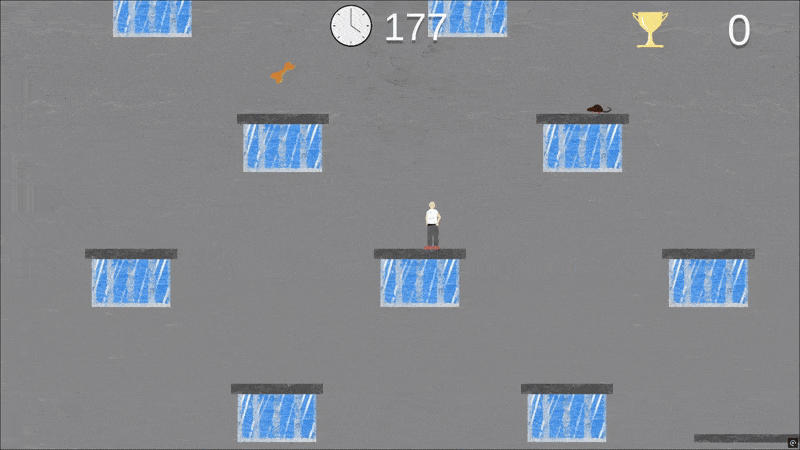Biscuit Boss
By Aditya
Published on
Introduction
This game is a vertical-scrolling 2D platformer with random level generation and surreal comedy, designed for casual players in the browser. Created for Brackeys Game Jam 2025.2 with the theme "RISK IT for the BISCUIT." The jam lasted one week. I was the game director and lead developer. I've teamed up with two programmers, RobyDev from Spain and Shinespark from USA; an artist, Francisco Martins from Portugal; and a composer, Aylinel from Germany.
The Core Idea
I came up with the concept for this game while thinking about taking risks for collectibles. The player starts at the bottom, climbs up the platforms, collects biscuits, and comes back down before the time ends. Will the player take a risk and go higher to collect more biscuits or will they come back down? The random level generation is meant to increase replayability value.
Early Prototyping
We started prototyping in Unity. The first version of the level generator spawned only one platform per row. At the time, there was a possibility that a platform would be spawned right above another platform, leading to the player character being unable to climb. I resolved this issue through code.
Scope and Prioritization
We initially considered adding wall jumps, but I discarded the idea because our level generation system wasn't ready to reliably produce walls, and adding the mechanic would have pushed the scope beyond what was feasible in our jam timeframe.
The early version of level generation included platforms of various sizes. I standardized all platforms to a single size. This reduced technical complexity, kept scope realistic, and ensured we could meet the jam deadline.
I initially considered five enemy types but chose to implement only two to keep scope manageable and ensure we met the jam deadline.
Team Coordination
We used Github for collaborative development and Google Sheets to communicate which tasks needed to be done and in which order.
I implemented player movement, the majority of level generation, enemy behaviors, and a few minor elements. Shinespark implemented the leaderboard system. RobyDev handled the rest.
The art style was established before the game concept was finalized. Once we had a working level generation system, I was able to evaluate the gameplay pacing and guide the composer on the type of background music needed. This approach ensured that both the artist and composer had sufficient time to create and polish the necessary assets.
Iteration and Problem Solving
One of the biggest challenges was designing the level. I wanted the player to have more than one way to go up. This meant there had to be more than one platform per row. I also wanted to have an easy way and a hard way. The easy way would have higher chances of spawning biscuits and fewer chances of spawning enemies while the hard way would have higher chances of spawning enemies and fewer chances of spawning biscuits.
One of the variations I tried had three platforms per row. This was discarded as it was not leading to an interesting level design. Another variation I tried had only two platforms per row and this lead to an occasional problem where the space between the two platforms would be too high and the player character would not be able to jump from one platform to the other in the same row. I solved this problem by measuring the distance between the two platforms in a row and spawning a third platform in between them if the space was too high. This lead to a balanced level design with two platforms in some rows and three in some rows.
To prevent only one side being easy and the other side hard, I wrote the code in such a way that the game would randomly choose between left and right side for the easy and hard platforms to be spawned. In the early version, biscuits and enemies would spawn on every 5th row. This was later changed to every 3rd row. This decision was made so that climbing platforms would feel more interesting with collectibles and enemies appearing more frequently.
The enemy drones are spawned on the right side of the screen and moved to the left side. At times, the player character would be too close to the drone when it was spawned and the player would not have enough time to move away from the drone. To solve this problem, I wrote the code in such a way that the drone would be spawned only when the player character is in the center or left side of the screen.
I wanted the round to end when the player reached the boss after collecting at least one biscuit. At the same time, falling from a height should result in the player's death. We realized this could create a conflict: if the player fell near the boss, it might trigger unintended behavior or bugs. To solve this, I added a platform above the boss, ensuring the player couldn't fall in that critical area and maintaining the intended game flow. This decision allowed me to enforce clear rules while keeping the gameplay predictable and bug-free.
Art, Audio, and Narrative
I wanted the art style to be painterly and the audio to feel like it was made with real instruments. I asked the composer to create gameplay background music that would feel similar to Super Mario Bros and Double Dragon II themes. I wanted the narrative to feel silly and surreal. So, we came up with the idea that an employee is being ordered by their boss to carry out a strange task.
